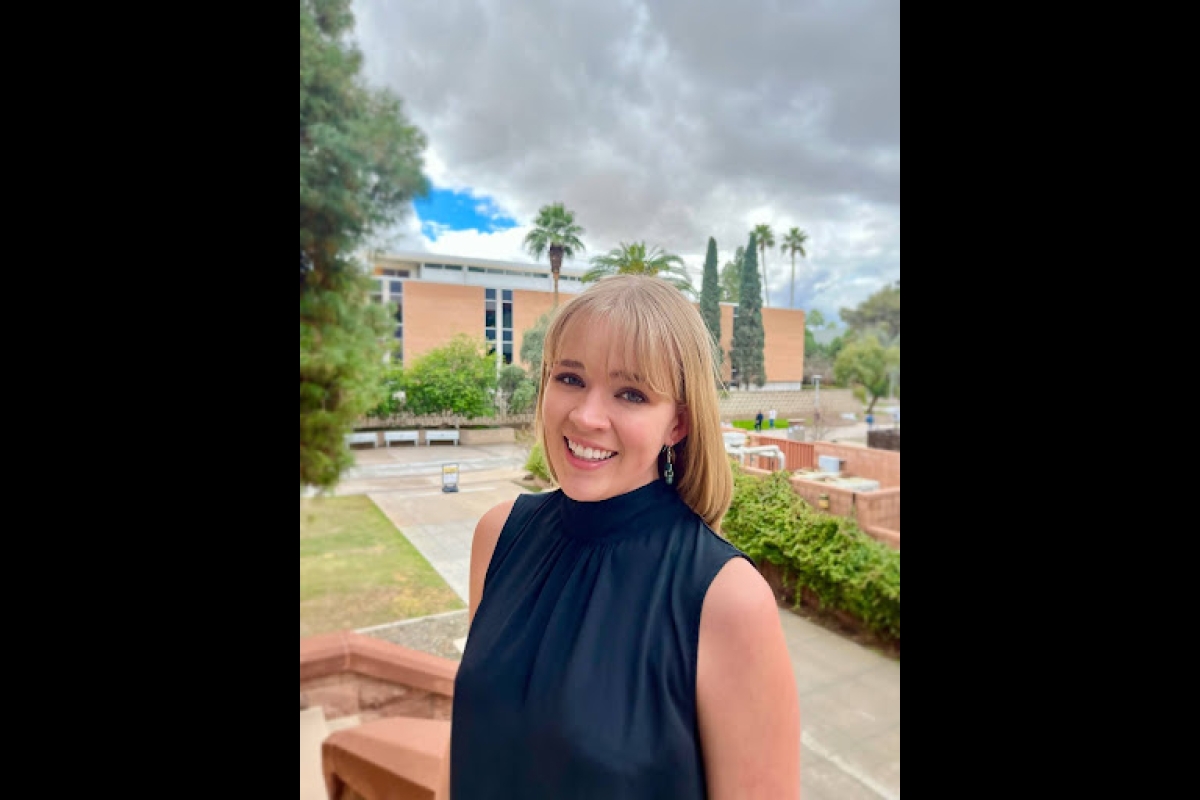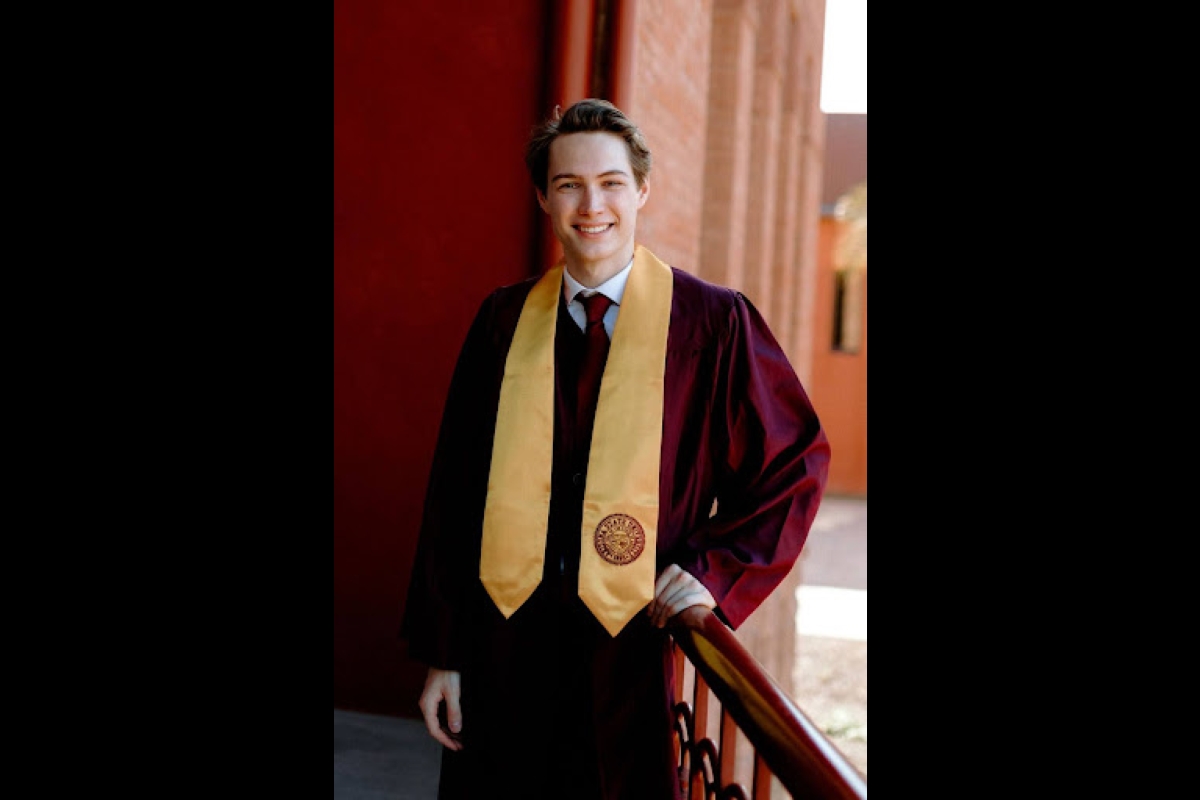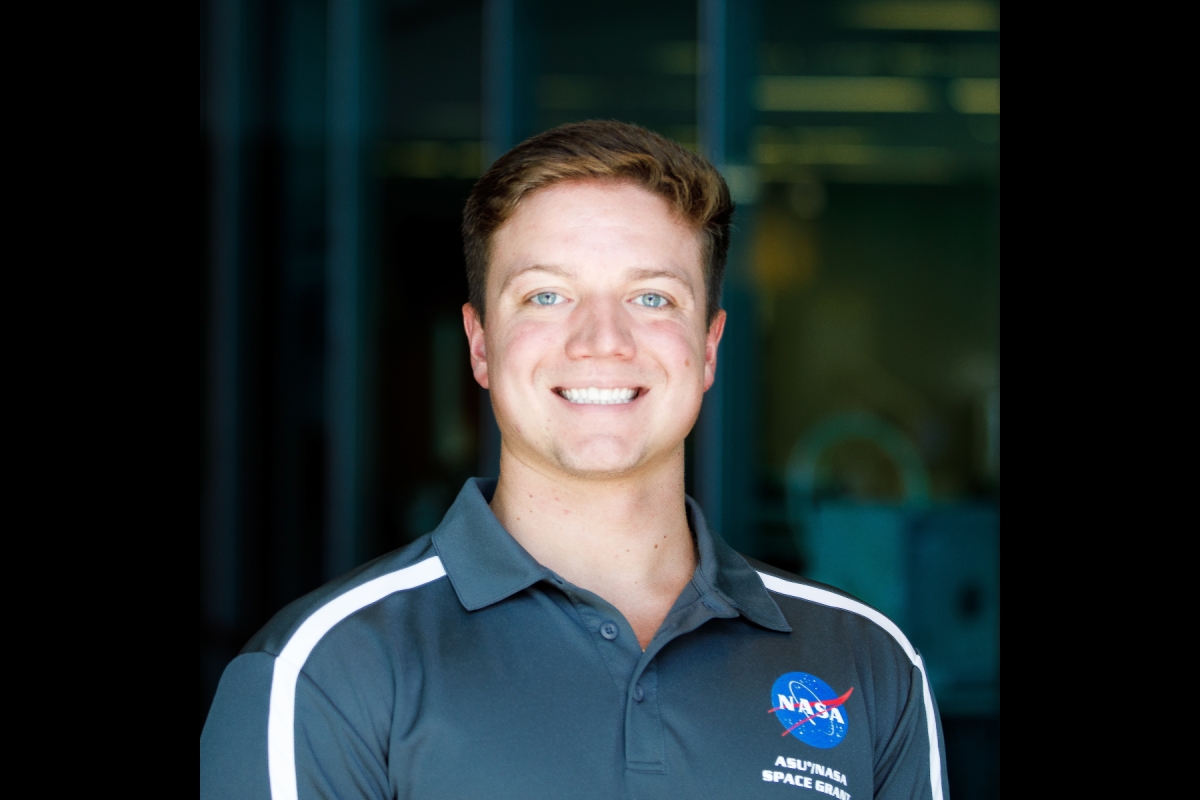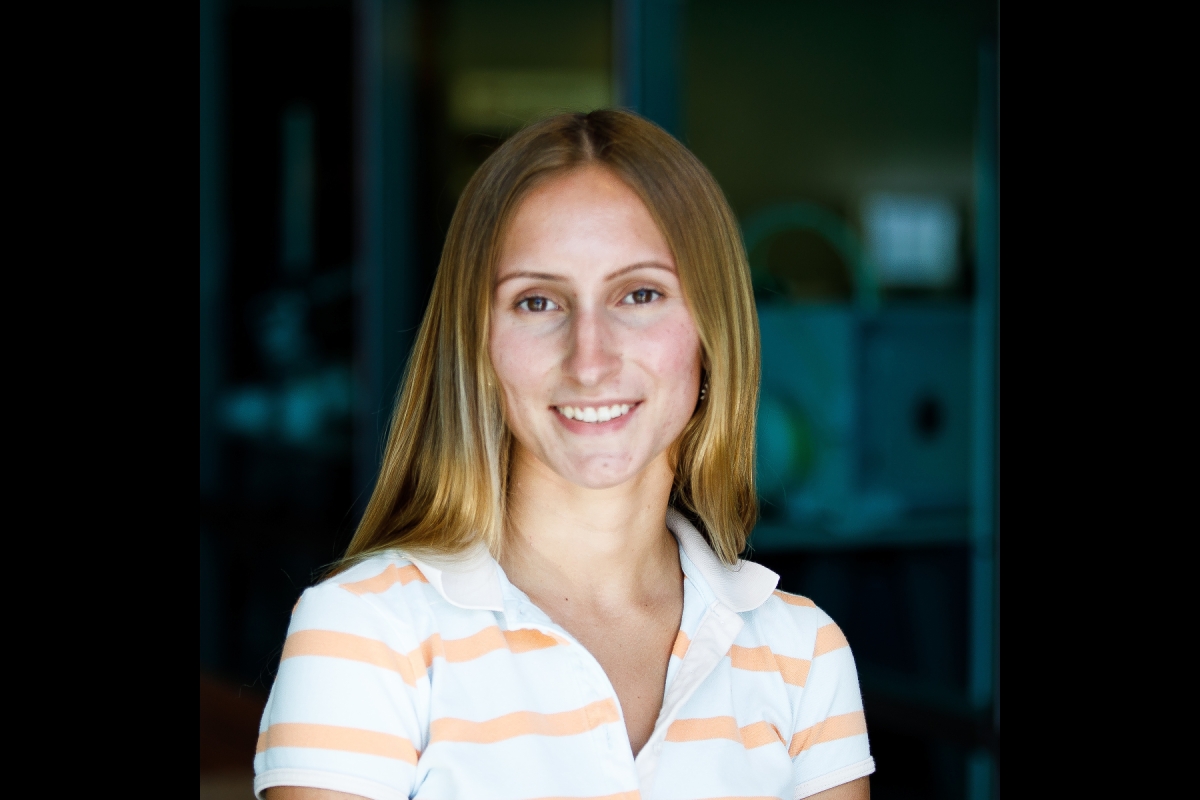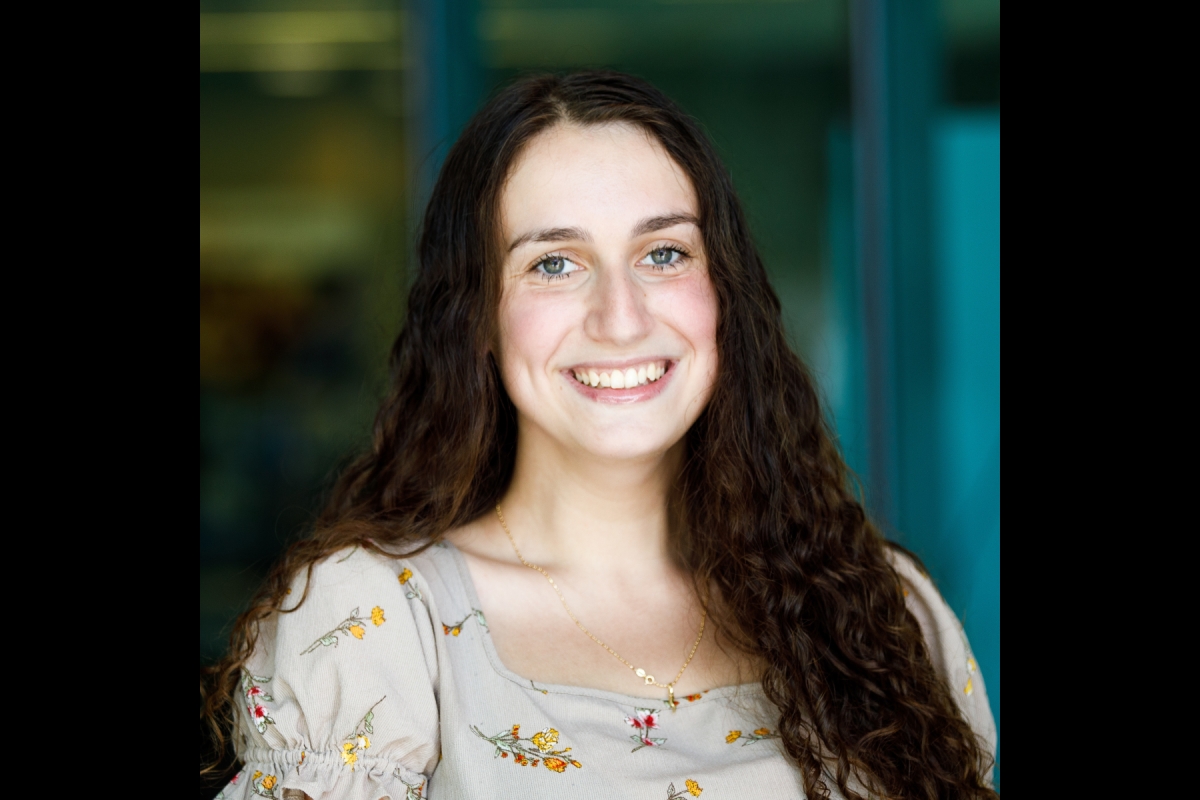Interplanetary Initiative grads prepare for their next frontiers
Students from across ASU reflect on their time in initiative's educational programs
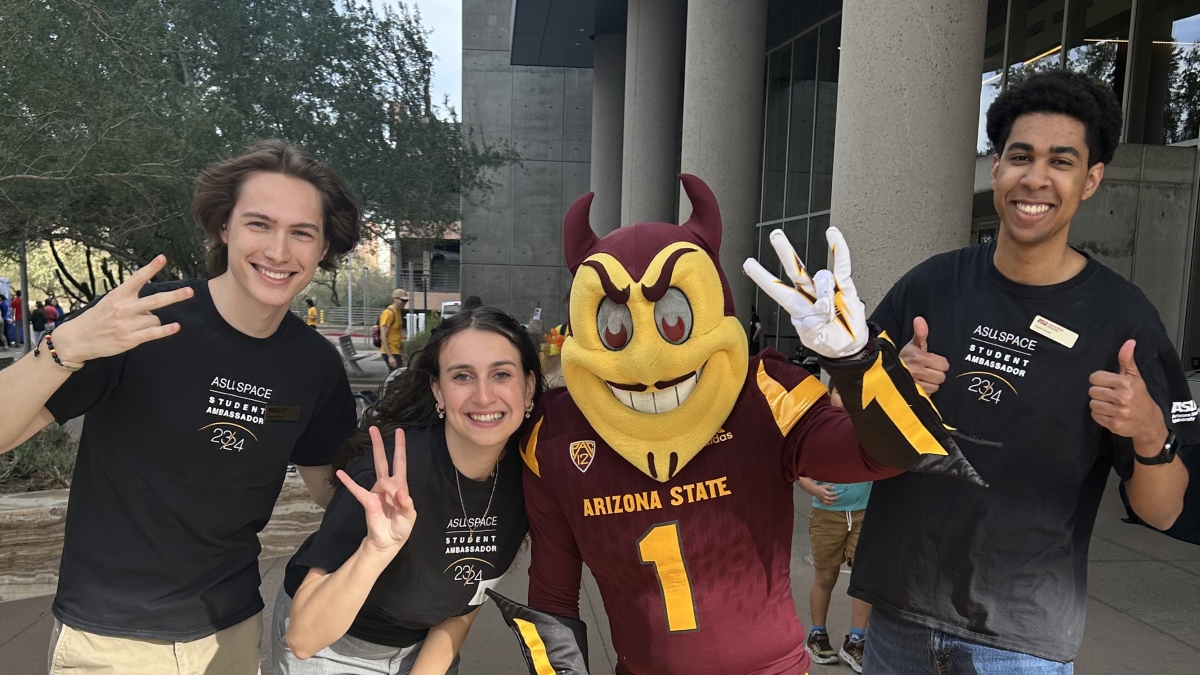
(From left) ASU seniors Lucas Barduson and Victoria DeFazio pose with Sparky and ASU junior Taylor Foster. Barduson and DeFazio, who both took part in the ASU Space Student Ambassador Program, are graduating this spring with bachelor's degrees in aerospace engineering (astronautics), and astrophysics, respectively.
As the spring semester comes to an end, Arizona State University's Interplanetary Initiative is celebrating a range of graduating students who have contributed to and benefited from its diverse educational programs.
Whether by taking advantage of Interplanetary's 6,800-square-foot small satellite laboratory, spreading the word among peers about getting involved with Space at ASU or graduating with Interplanetary's technological leadership bachelor's degree, these students took an active role in shaping their own unique educational experiences while promoting the initiative’s mission to build an inclusive and sustainable interplanetary future.
We took a moment to connect with a few of these outstanding students as they prepare for their next frontiers after graduation.
Student-led spaceflight projects at the Interplanetary Lab
At the south end of Sun Devil Hall on ASU's Tempe campus, the Interplanetary Lab is a state-of-the-art “space makerspace” prepared to support the full life cycle of spaceflight hardware and software.
It's also a place for students across a wide range of disciplines to participate in research projects, student club projects and collaborations with industry partners. Students Chandler Hutchens, Sam Cherian, Ben Weber and Genevieve Cooper had the opportunity to leverage the lab across a range of projects.
Hutchens, a master's degree student in aerospace engineering, is particularly proud of his experience as a lead systems engineer with the Deployable Optical Receiver Aperture (DORA) project. The DORA CubeSat aims to demonstrate improved technology for inter-spacecraft communication among small spacecraft. The CubeSat is slated for delivery to Nanoracks and NASA this May.
"Getting hands-on experience with a CubeSat, experiencing the design process and being able to make mistakes — and learning from them — was incredibly useful for obtaining an internship and now a job with Northrop Grumman," said Hutchens, who after graduation will move to Chicago for his new role as a spacecraft systems engineer.
Though his proudest Interplanetary Lab achievement was his work on the DORA project, Cherian — an undergraduate aerospace engineering student with a focus in astronautics — also built in-demand industry skills with tools like Ansys Systems Tool Kit (STK) and computer-aided design (CAD) software. His time at the lab allowed him to unearth an unexpected practical skill that comes in handy in his line of work: taking photos.
"Take lots of pictures," Cherian recommended to current and future engineering students. "If something goes wrong, it helps to have photos as evidence of how you got there. This helps you come up with a solution."
Weber, who's graduating with a BSE in aerospace engineering, also participated in the DORA project. He was equally involved in the Interplanetary Lab's dedicated ground station, which provides radio and tracking antenna technologies that enable researchers to "drive" and send commands to satellites.
"The lab has exposed me to several different concentrations of engineering in the space industry that I didn't know about beforehand," Weber said. "This really changed my perspective on what I wanted to do with my career, from rocket propulsion to controls engineering."
Weber is planning to go into the Peace Corps to teach in Tanzania, where he'll help teenagers and young adults develop their mathematical skills and discover STEM opportunities.
Cooper, a computer science major, contributed to many projects at the Interplanetary Lab. She said her experience across multiple roles — all of which stacked on top of her regular course load — helped her develop strong study and work habits, as well as practice working in a fast-paced team environment.
"Space inspires us with both fear and curiosity," Cooper said. "When we explore space, we also explore what it is to be human in a way we cannot do on Earth. The difficulties space exploration presents allows us to adapt and to overcome our fear only by working together."
Cooper plans to continue working at Honeywell's research and development division, where she has been an embedded software engineer for nearly a year.
Students interested in pursuing their research aspirations with the Interplanetary Lab are invited to reach out to the lab using its online form.
Preparing the problem-solvers of the future
Through coursework focused on individual and team-based research, technology design, mathematics, writing and coding, students pursuing the Interdisciplinary Initiative's Bachelor of Science in technological leadership receive a highly multidisciplinary education. Matthew Marquez, who will graduate from the program this spring, said it's this very approach that helped him feel prepared for a career in the space industry.
"The training and coursework throughout my degree has reinforced the need for an interdisciplinary curriculum for an evolving workforce for space," Marquez said. "The program allowed me to learn to code, engineer solutions to problems, conduct research, learn how to present my findings and even work with NASA on my idea of using ChatGPT as a research tool."
It's through the degree that Marquez found internships and the opportunity to join the ASU Space Student Ambassador Program. He also had the chance to work with the Mastcam-Z team led by ASU Professor and NASA principal investigator Jim Bell.
"Working with the Curiosity rover and seeing firsthand images of Mars has been a dream of mine for a long time," he said. "I feel blessed for the opportunity to work with such an amazing team."
Those interested in learning more about the technological leadership degree program can visit the program's webpage to review the major map, accelerated program options, attendance choices and more.
Representing ASU as student ambassadors
The ASU Space Student Ambassador Program offers undergraduate students the opportunity to develop leadership skills within a tight-knit peer group. Ambassadors serve as representatives of Space at ASU on campus and at exclusive industry events while completing projects that hone vital career skills. Of this year's 17 ambassadors, six are graduating this spring.
Kylie Wetnight, a W. P. Carey School of Business honors student studying business with a concentration in global politics, joined the ambassador program because of its inclusive approach.
"Being a business student, I found it difficult at first to get involved in space — many resources were aimed at engineering students," Wetnight said. "The ASU Space Student Ambassador Program allowed me to meet a diverse group of people that have similar interests. I'm now confident that there is a place for everyone in the aerospace industry."
Wetnight is applying for business development positions at aerospace and startup accelerator programs across the U.S.
Lucas Barduson is graduating with a bachelor's degree in aerospace engineering with a concentration in astronautics, as well as a double minor in physics and technological entrepreneurship and management. He founded the Space Coalition, a unified structure connecting all of ASU's space clubs into one collaborative community.
"The space ambassador program has dramatically changed my career trajectory for the better," Barduson said. "I’ve known from a very young age that I wanted to go into the space sector, but through my experiences as a space ambassador, my awareness of the landscape has become much wider."
Barduson is preparing to attend the NASA Academy at Langley Research Center in Virginia, from which he hopes to transition into a permanent role at NASA.
Ralph Ortiz, who's graduating with a degree in astrophysics, said the ambassador program made him more enthusiastic about the new space age.
"So many new companies, observatories and developments are contributing to space in a multidisciplinary way," Ortiz said. "No matter what you are doing as a student, I know that there is some way to do it with or in space."
Wren Heiligenstein is an honors student earning a bachelor's degree in astrophysics. Three of her primary interests — space, art and nature — intersected during the Desert Botanical Garden's Museum of the Moon event, where Heiligenstein volunteered in February. She is planning on pursuing a PhD in astrophysics at the University of Florida.
Marquez's top experience from the program was meeting retired astronauts Chris Hadfield and Cady Coleman during the Interplanetary Initiative's Space Futures Convening in February. Through the program and the convening, Marquez found it "refreshing" to be among others who are working to address real-world problems expected to disproportionately impact his generation. He's readying for an internship at the Texas-based company Astroport Space Technologies.
Victoria DeFazio, a senior majoring in astrophysics and minoring in Italian, became an ambassador out of her passion for space education outreach. She urges students interested in space research or outreach to get involved as soon as they can.
"My only regret was waiting until junior year to start getting involved in student organizations," she said. "I was too nervous to start sooner, but at a certain point you just have to go for it. The more involved you are, the more opportunities will come your way!"
Interested students can learn more about the ASU Space Student Ambassador Program on Interplanetary's website and subscribe to the ASU Space Student Mailing List to be notified of upcoming application windows.
More Sun Devil community

ASU Online alumna overcomes adversity, becomes advocate for military families
Editor's note: Arizona State University alumni are making a difference in every corner and community of the world, positively changing the lives of those they encounter. For National Military…

ASU's Earned Admission program paves the way for second chances
Over the past few weeks, students across the nation celebrated significant milestones — National College Decision Day and commencement, for example. But not everyone gets to make a decision to go to…

Inaugural cohort from Ukraine graduates with dual degrees during wartime
The American University Kyiv opened its doors in February 2022, just three weeks before Russia's invasion of Ukraine. Despite the tremendous challenges that followed, the school and its students…



